A former “sea lawyer” goes back to school to revisit the rules for how to sail a boat on a race course.
A very long time ago, I got my hands on the USYRU Appeals Book. It was a short/wide 3-ring binder. In it was the “case law” for the rules of sailboat racing.
I don’t remember how I got it. But, I remember where I opened and started reading it: in a Burger King somewhere in Midtown-East. That makes me wonder if I picked it up at the New York Yacht Club in the 40’s, where the YRALIS had a small “front desk” thing going on.
Anywho, I remember getting grub and going to the downstairs seating area. I ate, and went through the right-of-way section. I started highlighting those appeals that mattered: the ones that dealt with the less obvious “what ifs” of sailboat racing. For all the good it might do…
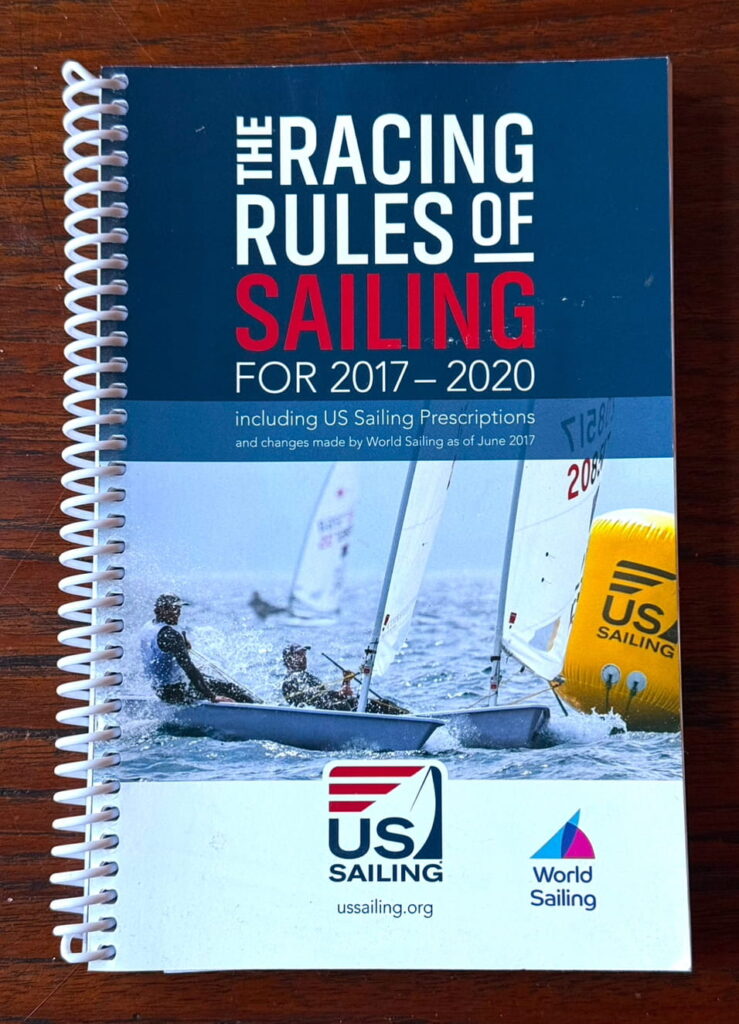
Did I become a “sea lawyer?” No. Not in the generally understood sense of the term. That would mean I was always getting into it with other racers, yelling, threatening, protesting, etc, etc. That wasn’t me. I just wanted to understand the rules and be able to race within them. Sure, that meant having the occasional tactical advantage, and sometimes enforcing it by speaking up on the race course, but always better to avoid tiff and just sail the race.
The idea was to steer clear of trouble, not look for it.
The basics of the racing rules are, basically, like those that apply to everyone else. One is a common sense rule: don’t hit shit from behind. That leaves two other basic rules:
- A boat with the wind coming over its starboard (right) side has right of way over the opposite (wind coming over port side). When “steam” (power) driven vessels emerged, the equivalent was that when crossing, the one on the right had right of way. Then, cars came along and, well… same.
- When two boats both have the wind coming over the same side, the leeward (downwind) boat has right of way.
But, racing is more complicated. We deliberately cram ourselves into tight quarters and turns, often at speed, and have to deal with the mess when we converge. So, the details are tricky.
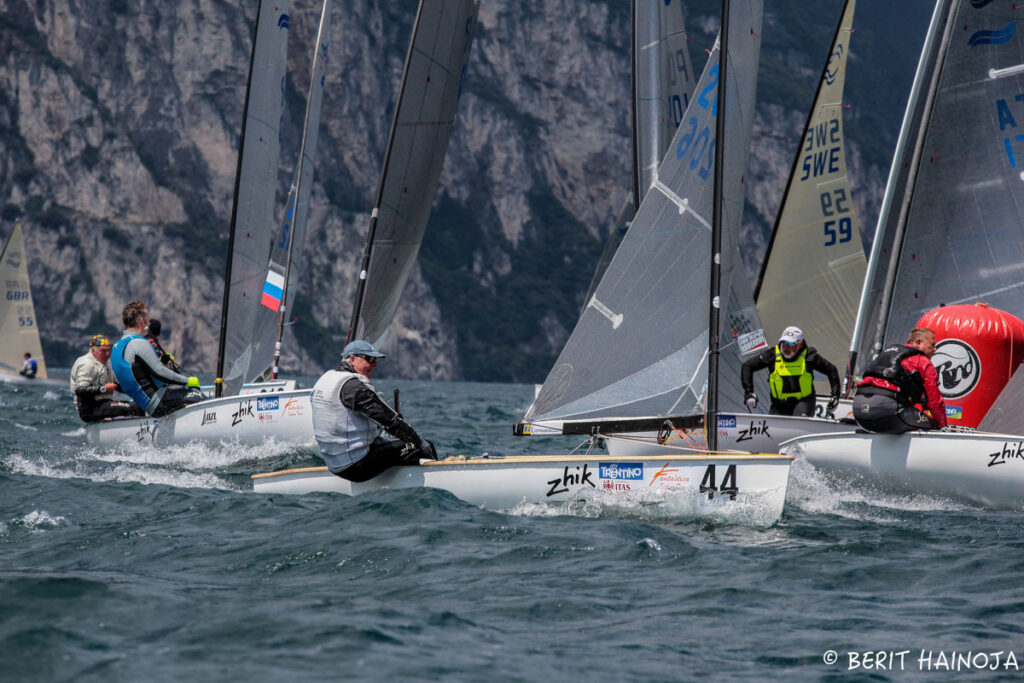
The appeals help sort out some of these situations for racers. It starts with a protest, when one boat calls out another over an alleged foul on the race course. If the protested boat doesn’t agree and do penalty turns, there’s a protest hearing after the day’s racing. If the loser of the appeal isn’t satisfied, they can appeal it. The race committee for the event organizes an appeals committee..
If THAT doesn’t go their way, and they want to keep it real, they can further appeal it. Ultimately, for America, US Sailing (formerly United States Yacht Racing Union, and before that, North American Yacht Racing Union) is the Supreme Court of sailboat racing. World Sailing is the global Supreme Court.
One appeal in particular always stood out for me. It dealt with mark roundings. Most sailboat racing involves crossing a specified starting line, turning around specified marks, and crossing a finish line (often the same as the start). When boats meet at those marks, the rules get tricky.
Without worrying about all those rounding rules, we’ll just talk about one principle: room at the mark, or “mark room.” Sometimes, one boat has to give room to another to round the mark, or go first. Everyone who races is at least vaguely aware of how that works.
When a good chunk of the fleet arrives at a mark roughly at the same time, it’s chaotic. Boats that are denied room at the mark have to keep clear. There might be nowhere to go! Sometimes, however, a boat that’s ahead and doesn’t have to give room makes a bad rounding or turn. That can leave room that wasn’t intended. What’s a boat to do?
If you’re coming in from behind, you can take advantage of “room given in error” (formerly, room “freely” given). So, if you get to the right place at the wrong time, but another boat struggles and swings wide, it’s fine to swoop into the gap and round the mark inside of the other boat and wind up ahead.
In my racing experience, going back to the 1980’s, this concept goes beyond being misunderstood. Most people never heard of it. It was the case then; it’s still the case now.
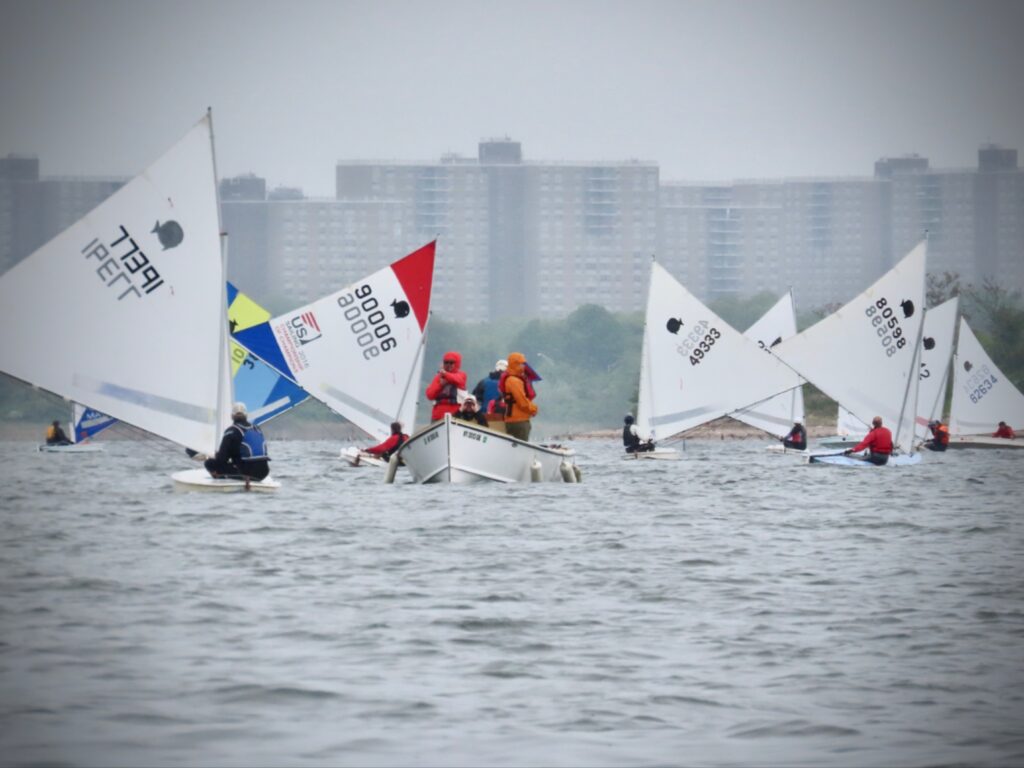
Back when I was frostbiting in Dyer Dhow dinghies, this came up once. Bud MacIntyre (might be misspelling his name) was a nice guy in the fleet. He was ahead of me as we approached a jibe mark, which is when sailing diagonally downwind, a boat has to execute a “jibe” turn to get around the mark and on course towards the next one further downwind. The course change was typically 60-90 degrees. Jibing means crossing through the wind ass-backwards, when the winds is from behind the boat, and the sails cross over.
I was behind and slightly to the mark side of Bud. I didn’t qualify for “room at the mark.” But, Bud was a big boy. Barely fit in that little boat. He got tangled up and swung wide of the mark, slowly and painfully. He knew I was there and said “don’t go in.” Several times, I think. I don’t remember if I said anything, much less what it was.
(I do know what I’d say now: “Try and stop me!”)
Anywho, Bud swung way wide and gave me more than wee room. I took it and went inside of him at the mark. There was no contact, and he couldn’t shut me out much less round the mark well. He couldn’t have hit me if he tried. (If he could, and did, I’d have to do penalty turns or risk being protested and disqualified.) Of course, he protested. There was a hearing. He said I didn’t have room at the mark but went in anyway. I said he swung way wide and left a ton of room, and couldn’t defend the hole by hitting me if he’d tried, and that I was entitled by the appeal (case law) to take advantage of room freely given.
Despite the facts not being in question, and the appeal ruling being clear, they disqualified me – even though there wasn’t any contact. For that low-level of Sunday afternoon frostbite racing, that was silly. But, it’s what’s done, and why it’s best to avoid protests and hearings if at all possible. The people who decide it are on the spot, and usually not up to the task -which is a thankless one, really, when everyone is out playing together and then some have to referee a squabble. No good comes of it.
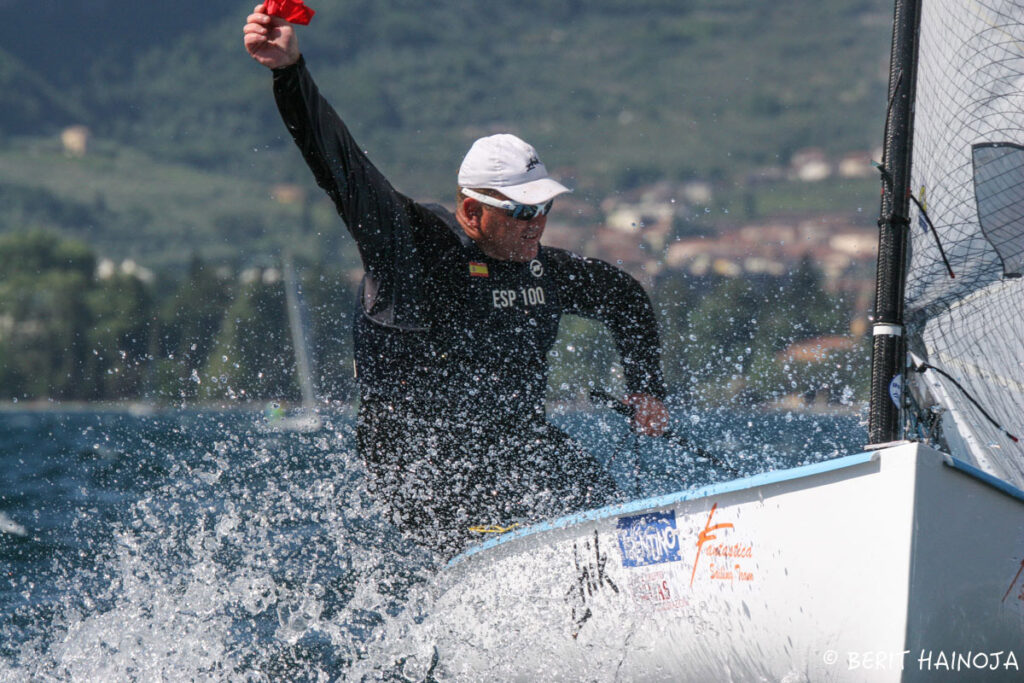
Fast forward many decades. A client and friend of the school, who took some cruising classes with us and joined the Club, was racing a boat in the Virgin Islands. There’s a series where one can charter a boat and participate. He was protested and disqualified in a race, and asked me what I thought.
The details were different, but the concept was the same: room was given and he took advantage of it. When his competitor lost ground to him based on losing the boat-to-boat duel, said competitor got pissy and protested. Loser.
Unfortunately, he became a winner (at least compared to my buddy) because he won the protest. My buddy got a DSQ. He asked me to look it all over and give my thoughts. I did; and that required revisiting the racing rules.
The rules have changed a lot since I was regularly active in racing. They were simplified; oversimplified, if you ask me. (BTW: check out the YouTube channel “Oversimplified” for quick, cartoon-art videos that whittle down historical events to bite sized chunks. Super entertaining.)
It’s much easier if something is added; WAY harder to deal with simplification or subtraction. So, there was that: get acclimated to the new rules. Truth: I’d been racing again, starting in ‘23, and had NOT learned the rule changes. So, I figured that until I did, I’d avoid trouble. If in doubt, turn away from the other boat. I really should have re-learned the rules properly before I got on the race course, but it was super friendly club racing and I could get away with it.
So, I re-learned the rules more or less. Then, I re-visited my buddy’s situation. My original conclusion had been that he was in the right: he’d taken advantage of room given in error/freely. I also found a new rule that went even more in our direction: when a right of way boat alters course, they must initially allow room for the other boat to keep clear. This is more limiting on the right-of-way boat, and should also have helped his case, which was…
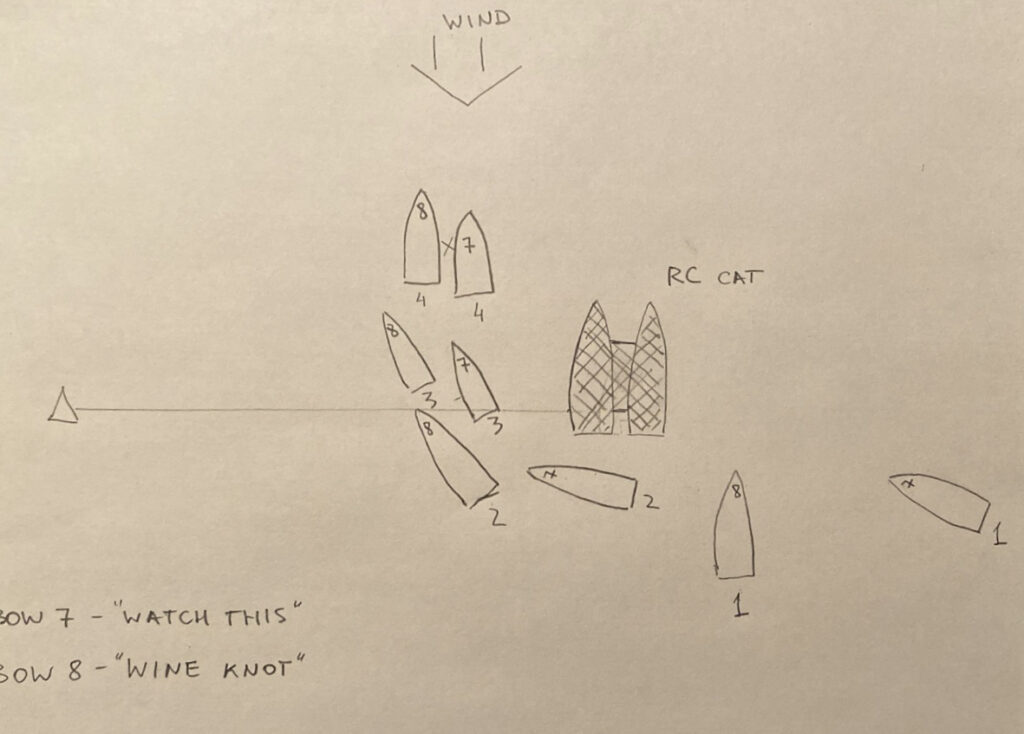
He was sailing toward the starting line, specifically the anchored committee boat. Ahead of him was the competitor in question. (This was a fleet race; no other boats were close or relevant to this sequence so they’re not shown.) Let’s call them boat A (asshole) and boat B (buddy). Boat A hovered head to wind (pointing directly at the wind) motionless or nearly so. He was blocking the route Boat B would take, to pass directly downwind/behind the committee boat and then head up toward the wind to cross the line and start.
(nb: in the diagram above, “A” is #8 and “B” is #7.)
Something would have to give: Boat A would have to turn away from the wind at some point and actually sail if he were to cross the line and proceed toward the first mark. But, if he didn’t do so before Boat B arrived, B would have to dip below/behind A and hope to make up the lost ground with better speed. (When approaching a starting mark, the windward boat almost never has rights to room at the mark.)
Boat A, predictably, headed away from the wind to accelerate and cross the starting line. That left a lot of room for Boat B to sail in between him and the RC boat. He did. They both crossed the starting line (between RC boat and a mark way to the left, forming the starting line). Some seconds went by. Then, Boat A decided to alter course by heading up toward both the wind and Boat B. Boat B headed up too, as A was entitled to do that – but up to a point:
- Can’t go beyond “head to wind,” or you’re “tacking,” and lose all rights to a boat “on a tack;” or, at least that’s what it used to be…
- Under new rules, must initially allow the give-way boat room to keep clear. A did; B had time to keep clear at first, and did so, but stopped short of crossing head to wind. Had B done that, he would also be forced into the committee boat or its anchor. Therefore, A wasn’t entitled to force B past that point.
- Room freely given was almost not even relevant, but would force a competent race committee to ignore that complaint from boat A, which is what it protested about: A claimed B was “barging,” or trying to force its way in between boat A and the starting mark (which it’s not allowed to do). Barging isn’t a rule and isn’t mentioned in the rules, but it’s the common name for the situation. Rule that out, and one can then focus on the rules at hand (limits on altering course).
Boat A went beyond “head to wind,” and Boat B didn’t. A hit B lightly; no real damage. But, contact means both boats must retire (quit), or one must do penalty turns, or either/both must protest. If there’s contact, at least one must be disqualified after the hearing. (No contact? No requirement for a boat to be tossed from the race, although that’s the way it usually goes.)
My buddy in Boat B was DSQ’d as I wrote. Based on my opinion, he decided to appeal. But, he wasn’t able to get a written copy of the Race Committee’s decision and the appeal committee decided against him largely on that basis. (Reasonable, although unreasonable and odd that the RC didn’t supply the decision. Maybe they didn’t want to deal and/or be seen as correcting their own mistake, as RC and Appeals Committee might have overlapped.)
After I’d given him my initial opinion, I also asked for that of key members at Sebago Canoe Club where I race dinghies. Some of them race a lot, and travel to regattas both in the US and abroad. One guy (the most traveled) got back to me. He thought that Boat B was “barging” and didn’t have rights – which is exactly what everyone always thinks, and what the Race Committee thought as well.
I read the rules. I found the appeals. One source of help for that was Dave Perry. Look him up; he was a top racer back in his day and has been considered the pre-eminent rules expert for a long time. He’s the guy for US Sailing as far as rules are concerned. My Da and I saw him give a talk on racing back in the late ‘80’s somewhere in Connecticut, probably hosted by North U (North Sails’ educational arm). Nice guy. Well, I emailed US Sailing about the appeals; trying to find them in general and this one in particular. Dave and another fellow both got back to me.
Dave and I share a few things in common: we’re male members of the species, we’ve both lived in Connecticut, and we both raced Lasers and Solings. We’re both good at the rules (me in the past, and playing catch-up now; Dave always). The main difference is in the success level. According to North U:
While at Yale (1973-77) he was captain of the National Championship Team in 1975, and was voted All-American in 1975 and 1977. Other racing accomplishments include: 1st, 1978 Tasar North Americans; 5th, 1979 Laser Worlds; 1st, 1982, 2006, 2008, 2011 and 2015 U.S. Match Racing Championship (POW); 1st, 1983 and 1984 Congressional Cup; and 1st, 1994, 1999 and 2003 Ideal 18 North American Championship.
Dave also campaigned a Soling at the top tier, vying for but falling short of an Olympic berth.
Me? Largely learned to sail on Solings; raced them at the lowest, weakest level that existed; crewed for someone at a Soling East Coast championships once (zero tactical responsibility on my part and zero fucks given by the skipper for my opinion on anything); raced Lasers with some success at the District level (NYC/Long Island). Got back into Lasers two years ago; everyone considers me “fast.” Haven’t sailed a proper race in one yet since resuming (did so with Sunfish and Vanguard 15’s and, again, “fast,” and occasional moments of brilliance balanced by blunders and mediocrity in a low level fleet).
Dave spent some time getting acquainted with and helping me via email; I very much appreciated that. He put me onto the appeal I needed as well. It’s not the one I remember, but maybe I don’t remember it well. They do delete some and add others, so it’s possible the old one is simply gone and replaced by a “better” one. The concept is exactly the same, and it is in fact settled “case law.”
The net/net: here are the two appeals that apply to this particular race start.
First: Case 146 from World Sailing’s Case Book (Appeals). This one establishes that once a leeward boat (downwind, or to downwind side) lets a windward boat (opposite) in between itself and a starting mark, it can’t whine about it later. It also can’t force the windward boat into that mark. Normally, leeward has rights over windward, and can alter course toward it and make windward move. This is one of the exceptions those rights. The Case goes on to explain that “barging” isn’t a rule or discussed in the rules, and is only an issue when a windward boat forces its way in between a leeward boat and a mark. No force? No foul…
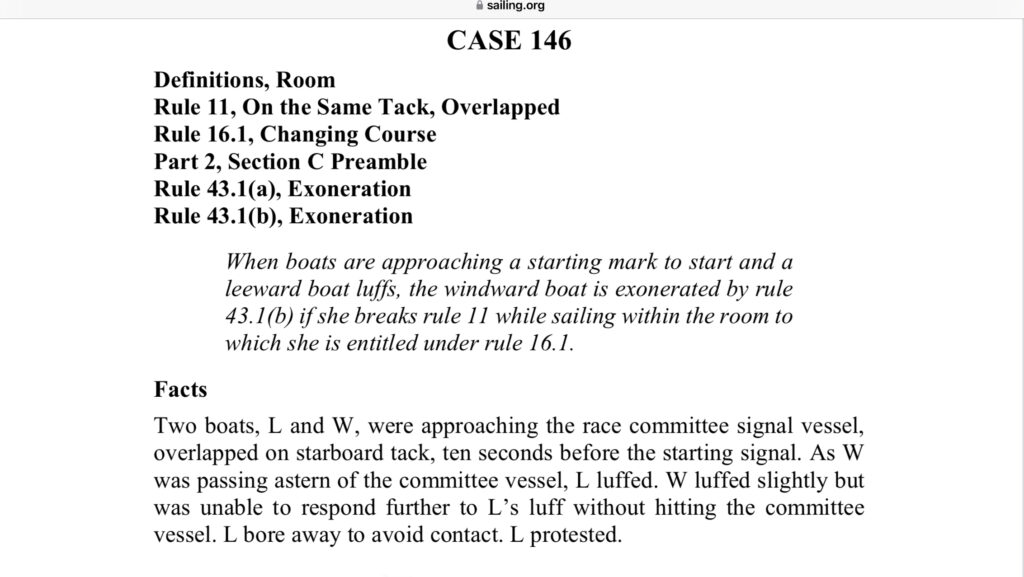
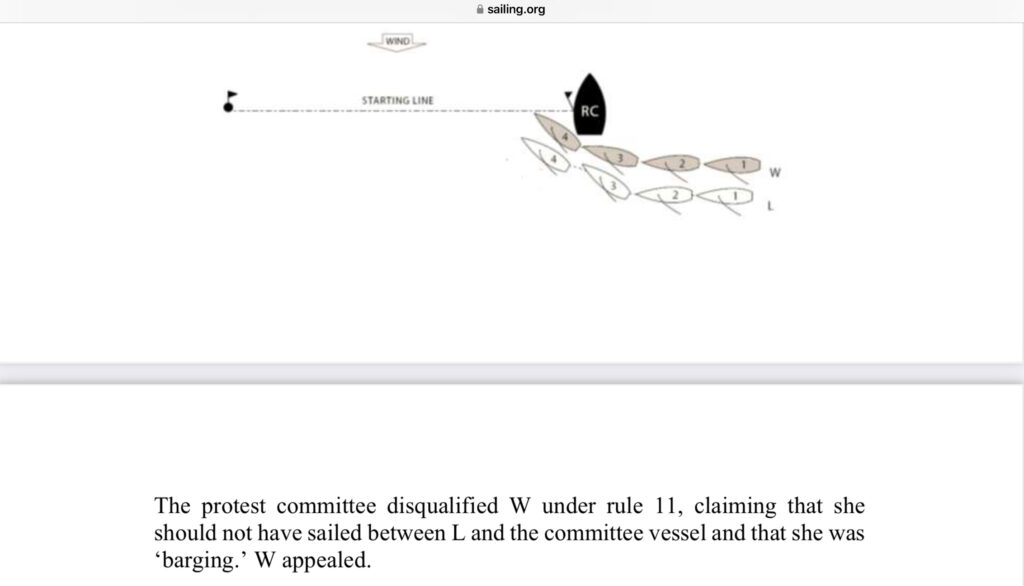
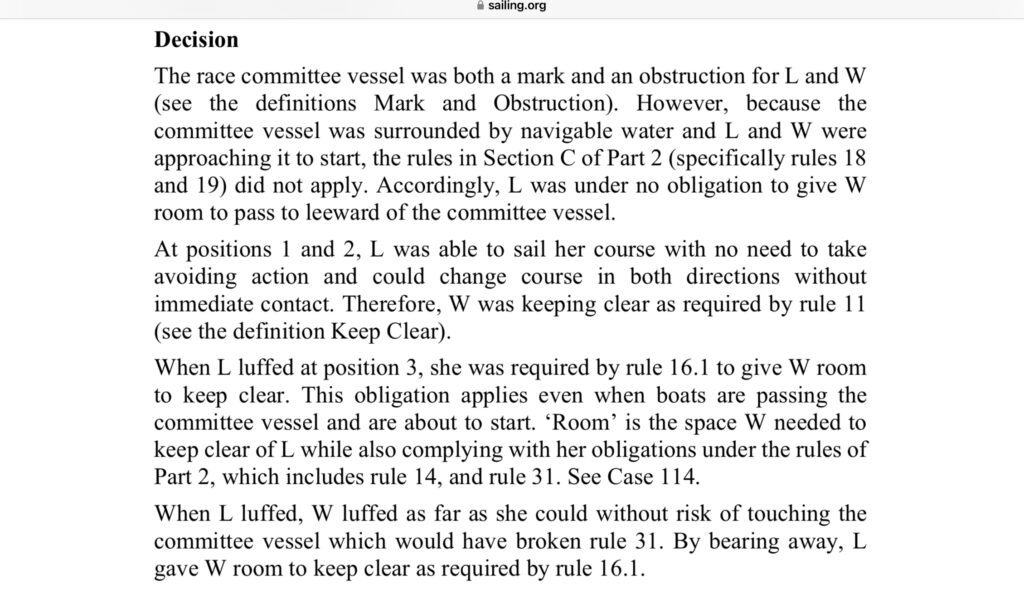
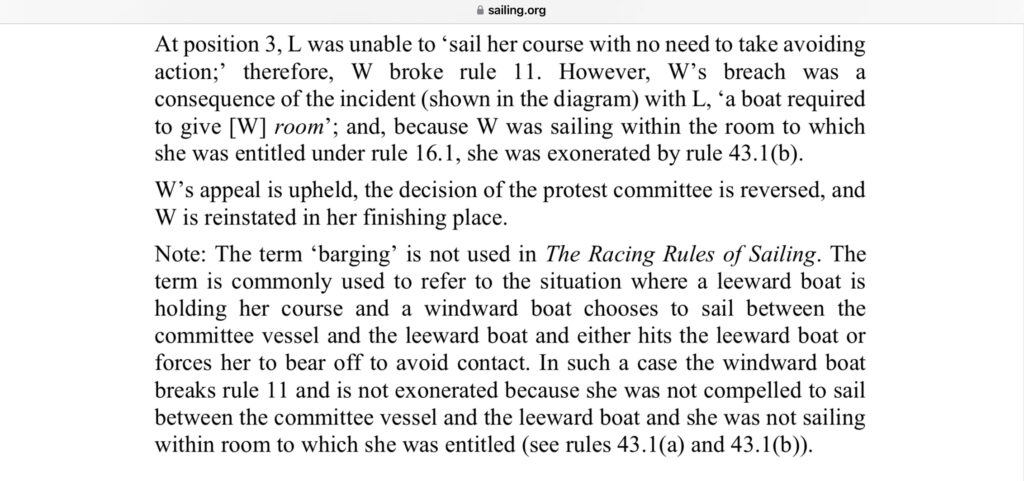
And now, the US Sailing Appeal on room given in error… Appeal #5, all the way from 1950!
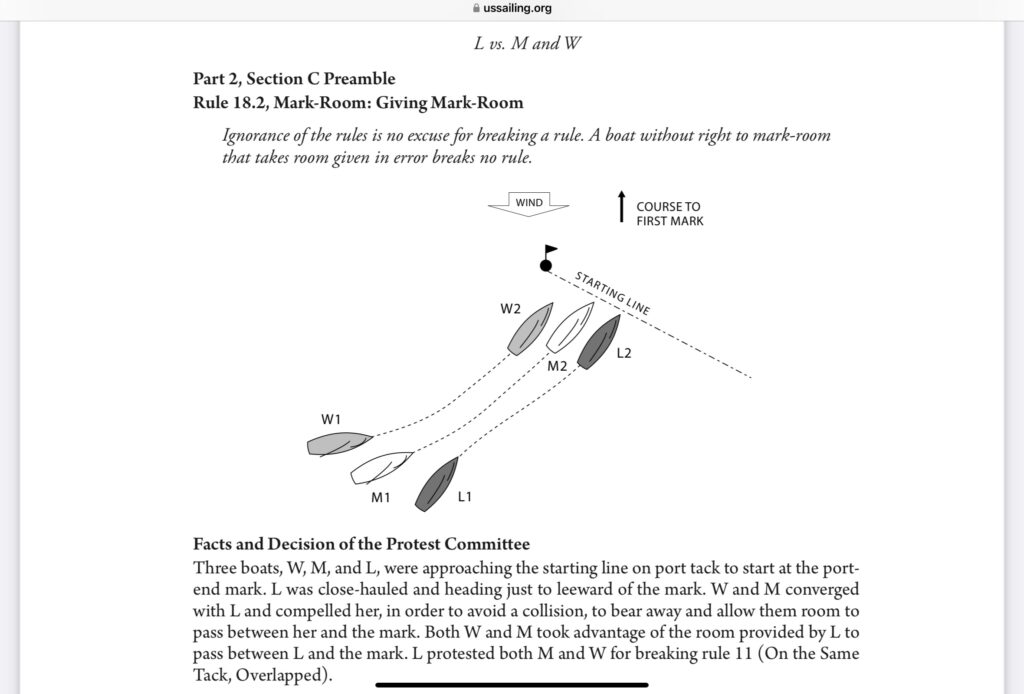
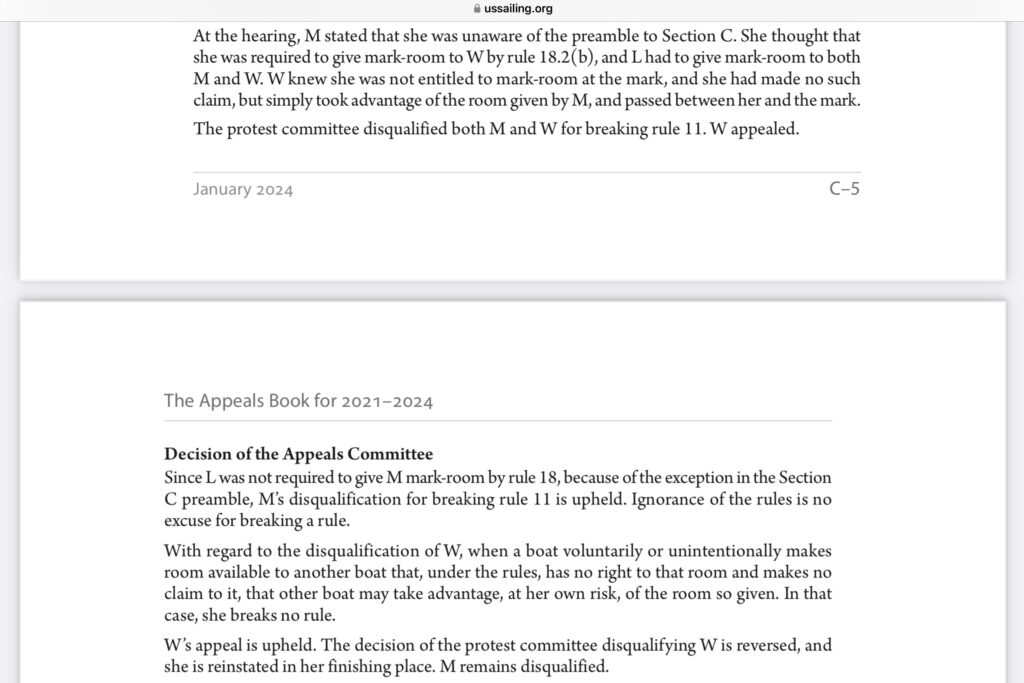
Appeal #5 is where it’s at. One of the older appeals; still as unknown today as it was back in my day. It’s the concept of room freely given (now room given in error). One takes a risk trying to take advantage of it, but if an “attacking” boat assesses the course well, and the boat being attacked – and not required to give room – is unable to do anything about it, for any reason, it’s fine to take that room. Common sense, IMHO. Yet, all anyone can think of is “barging.”
B-Buddy (real name Alex) decided that it was a very interesting learning experience and let it lay. He really didn’t have much choice. On the race course, one can usually make this choice: get into it with competitors, or just avoid rule confrontations. Sail faster and smarter, and enjoy playing by trying to win a sailboat race. Stay out of the courtroom. Leave that to the “sea lawyers.“
”Some of my best friends are lawyers.” In fact, my two best friends ever are lawyers. I’ve lost touch with one sadly (he moved to Asia). The other is right here and we still argue about whether his wife and he saw a large barracuda, or a small shark, on one of our Virgin Island trips. He knows all the lawyer/shark jokes.
Here’s one, told by the one I lost touch with. short version (want the long version? Post a comment in reply to this, and I’ll post the whole joke for ya!).
Why do sharks never attack any lawyers they find from shipwrecks?
Professional courtesy.
And, speaking of actual sharks, here’s a story relayed by a lawyer about a lawyer: https://www.drewcochranlaw.com/2019/08/06/lawyer-bitten-by-shark-and-other-jokes-that-write-themselves/
Plus: when looking up these lawyer jokes, came across this interesting piece on, of all things, a body-shop web site/blog: https://www.fenderbender.com/running-a-shop/operations/article/33021856/lawyer-jokes
Racing Rules, from World Sailing, 2025-2028 edition: https://www.sailing.org/inside-world-sailing/rules-regulations/racingrules/
US Sailing Appeals (red-lined edition): https://www.ussailing.org/wp-content/uploads/2021/01/Appeals-Book-2017-2020-Section-3-red-lined-edition-December-21-2020.pdf